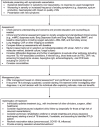Post-TB health and wellbeing
- PMID: 37035971
- PMCID: PMC10094053
- DOI: 10.5588/ijtld.22.0514
Post-TB health and wellbeing
Abstract
TB affects around 10.6 million people each year and there are now around 155 million TB survivors. TB and its treatments can lead to permanently impaired health and wellbeing. In 2019, representatives of TB affected communities attending the '1st International Post-Tuberculosis Symposium´ called for the development of clinical guidance on these issues. This clinical statement on post-TB health and wellbeing responds to this call and builds on the work of the symposium, which brought together TB survivors, healthcare professionals and researchers. Our document offers expert opinion and, where possible, evidence-based guidance to aid clinicians in the diagnosis and management of post-TB conditions and research in this field. It covers all aspects of post-TB, including economic, social and psychological wellbeing, post TB lung disease (PTLD), cardiovascular and pericardial disease, neurological disability, effects in adolescents and children, and future research needs.
La TB touche environ 10 millions de personnes chaque année et il y a aujourd’hui environ 155 millions de survivants de la TB. La TB et ses traitements peuvent entraîner des dommages permanents à la santé et au bien-être. En 2019, les représentants des communautés touchées par la TB participant au « 1er Symposium international post-tuberculose » ont appelé à l’élaboration des directives cliniques sur ces questions. Cette déclaration clinique sur la santé et le bien-être post-TB répond à cet appel et s’appuie sur le travail du symposium, qui a réuni des survivants de la TB, des professionnels de la santé et des chercheurs. Notre document offre une opinion d’expert et, dans la mesure du possible, une orientation fondée sur des données probantes pour aider les cliniciens dans le diagnostic et la prise en charge des pathologies post-TB et la recherche dans ce domaine. Il couvre tous les aspects post-TB, y compris le bien-être économique, social et psychologique, la maladie pulmonaire post-TB (PTLD), la maladie cardiaque et péricardique, la déficience neurologique, les effets chez les adolescents et les enfants, et les besoins futurs de recherche.
Figures









Comment in
-
Post-TB lung disease - the rationale for a Clinical Statement.Int J Tuberc Lung Dis. 2023 Apr 1;27(4):243-244. doi: 10.5588/ijtld.22.0674. Int J Tuberc Lung Dis. 2023. PMID: 37035975 No abstract available.
References
-
- Dodd PJ, et al. Quantifying the global number of tuberculosis survivors: a modelling study. Lancet Infect Dis. 2021;21:984–992. - PubMed
-
- World Health Organization Geneva, Switzerland: WHO; 2021. Tuberculosis.
-
- Datta S, Evans CA. Healthy survival after tuberculosis. Lancet Infec Dis. 2019;19:1045–1047. - PubMed
-
- Allwood B, et al. Post-tuberculosis lung health:perspectives from the first international symposium. Int J Tuberc Lung Dis. 2020;24:820–828. - PubMed
Publication types
MeSH terms
Grants and funding
LinkOut - more resources
Full Text Sources
Medical
Miscellaneous

